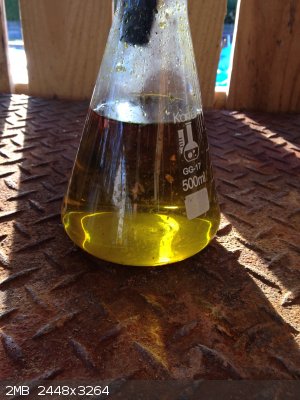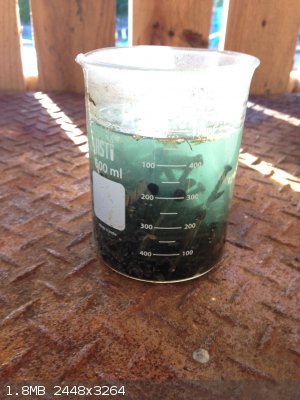A Halogenated Substance
Hazard to Self
 
Posts: 68
Registered: 7-2-2017
Location: United States
Member Is Offline
Mood: Oxidizing due to extended exposure to oxygen
|
|
Two colors from same nails and HCl
A couple weeks ago, I wanted to recycle some iron nails from a small construction project I was helping with. To do this, I took nails from old, worn
wood from an old fence and submerged them in hydrochloric acid (11.82 M) in a 600ml. beaker.
A few days passed and the solution turned yellow, indicating iron chloride(s).
I filtered the solution to get the iron chloride(s) and put the nails back in the beaker to react them once again with more hydrochloric acid.
This time however, the solution turned a light shade of green through the course of a week...
I looked up what other components could've caused this...
http://www.madehow.com/Volume-2/Nail.html
According to this site, nails additionally tend to have copper and nickel in them. Looking at the MSDS for the chloride salts for these metals, they
also are green.
Nickel: http://www.sciencelab.com/msds.php?msdsId=9926213
Copper: http://www.sciencelab.com/msds.php?msdsId=9923592
 
I suspect that the green color is more likely to be nickel as copper on an activity series chart is higher placed and also the complex created between
copper(II) chloride and HCl tends to be a much deeper green.
Does anyone have a better idea of what else this would be, if it is something else? Would the green product be worth extracting?
Thank you!
|
|
|
pantone159
National Hazard
   
Posts: 590
Registered: 27-6-2006
Location: Austin, TX, USA
Member Is Offline
Mood: desperate for shade
|
|
Could the green color be ferrous ion? In contact with the metal Fe, it might stay as Fe+2 despite the surface exposed to the air.
|
|
|
A Halogenated Substance
Hazard to Self
 
Posts: 68
Registered: 7-2-2017
Location: United States
Member Is Offline
Mood: Oxidizing due to extended exposure to oxygen
|
|
Quote: Originally posted by pantone159  | Could the green color be ferrous ion? In contact with the metal Fe, it might stay as Fe+2 despite the surface exposed to the air.
|
According to Sciencelab: https://www.sciencelab.com/msds.php?msdsId=9924050
But the previous solution turned yellow despite being in contact with the fresh nails though...
Both solutions were in similar conditions... Is there a coating on a nail that could've prevented the reaction between iron(III) with iron during the
first go?
|
|
|
Metacelsus
International Hazard
    
Posts: 2539
Registered: 26-12-2012
Location: Boston, MA
Member Is Offline
Mood: Double, double, toil and trouble
|
|
Were the nails somewhat rusty? (If you got them from an old fence, they probably were.) In that case, there may have been enough Fe(III) present at
the beginning to turn it yellow.
|
|
|
Texium
Administrator
       
Posts: 4581
Registered: 11-1-2014
Location: Salt Lake City
Member Is Offline
Mood: PhD candidate!
|
|
I think Metacelsus is most likely correct. The nails should be primarily iron. The Fe(III) hexachloro complex is very strongly colored, and you can
clearly see it as a bright yellow even at very low concentrations. At higher concentrations, it is dark reddish brown. You can demonstrate this by
dissolving a nail in nitric acid- iron(III) nitrate is very weakly colored, and then simply adding a drop of HCl to a dilute solution of it. It will
go from colorless to bright yellow as you swirl it together. Add some peroxide to your green solution and you should see it immediately begin to go
yellow-brown.
|
|
|